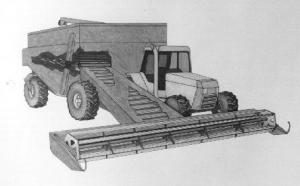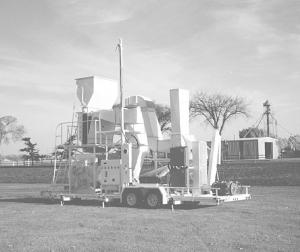1996 - Volume #20, Issue #6, Page #25
[ Sample Stories From This Issue | List of All Stories In This Issue | Print this story
| Read this issue]
Harvest System Eliminates Combines
 |
 |
The system promises to reduce equipment cost by 40 percent, cut grain loss by 2 percent, produce cleaner grain, remove chaff and nearly all weed seeds from the field, and mill docked material into livestock feed.
The idea is to use two machines instead of a single combine. The "harvester" mounts on an existing tractor. It removes grain, chaff, and weed seeds from the field, leaving the straw behind. In effect it harvests "dirty" without doing any separating or cleaning. It's equipped with a 20-ft. header and features a large 1,200 cu. ft. grain box compared to the 250 to 300 cu. ft. hoppers on most existing combines, says McLeod. It's designed to collect grain from 9 to 12 acres of grain before unloading.
The second machine is a stationary processing unit that can be located back at the grain storage area. It separates grain from the crop material gathered in the field and cleans it to export standards using new air cleaning technology. It uses a roller mill to crush and compress the collected chaff and weed seeds for use as livestock feed, litter, or for disposal. The processing unit, which has been built and is undergoing testing, is powered by a new-style 30 hp. single-phase electric motor.
"Grain loss out the back of the combine is eliminated, which saves an average of 1 to 2 percent over conventional combining methods. That means a savings of $2,000 for a 700-acre wheat field," says McLeod. "What's more, our harvester will bring weed seeds in from the field, reducing herbicide and tillage requirements the following year. As an extra bonus, the fat and protein con-tent of the crushed weed seeds adds value to the docked material if it's used as live-stock feed."
The prototype field harvesting unit is currently being built and will be tested extensively next year. Initially the system is being developed for small grains, but will also be adapted for use in corn, says McLeod, who expects the cost of the two machines to total about 40 percent less than a conventional self-propelled combine.
McLeod has been working on the new system for three years. He has received funding from various ag research organizations.
Contact: FARM SHOW Followup, Bob McLeod Inc., 670 Broadway, Winnipeg, Manitoba, Canada R3C 0X3 (ph 204 772-8650; fax 8827).

Click here to download page story appeared in.

Click here to read entire issue
To read the rest of this story, download this issue below or click here to register with your account number.




